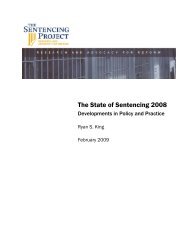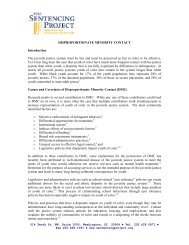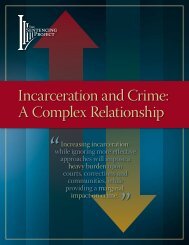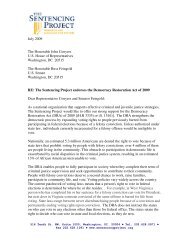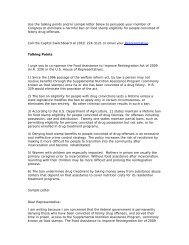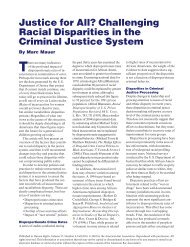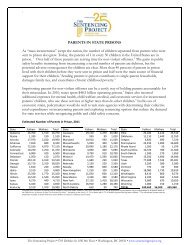Crack Cocaine Sentencing Policy - Prison Policy Initiative
Crack Cocaine Sentencing Policy - Prison Policy Initiative
Crack Cocaine Sentencing Policy - Prison Policy Initiative
Create successful ePaper yourself
Turn your PDF publications into a flip-book with our unique Google optimized e-Paper software.
514 10TH S TREET NW, S UITE 1000<br />
WASHINGTON, DC 20004<br />
TEL: 202.628.0871 • FAX: 202.628.1091<br />
S TAFF@S ENTENCINGPROJECT.ORG<br />
WWW.SENTENCINGPROJECT.ORG<br />
<strong>Crack</strong> <strong>Cocaine</strong> <strong>Sentencing</strong> <strong>Policy</strong>: Unjustified and Unreasonable<br />
Overview <strong>Crack</strong> cocaine became prevalent in the mid-1980s and received massive media attention<br />
due in part to the death of college basketball star Len Bias (subsequently found to have used<br />
powder cocaine on the night of his death and not crack). <strong>Crack</strong> was portrayed as a violence<br />
inducing, highly addictive plague of inner cities, and this media spotlight led to the quick passage<br />
of two federal sentencing laws concerning crack cocaine in 1986 and 1988. The laws created a 100:1<br />
quantity ratio between the amount of crack and powder cocaine needed to trigger certain<br />
mandatory minimum sentences for trafficking, as well as creating a mandatory minimum penalty<br />
for simple possession of crack cocaine. The result of these laws is that crack users and dealers<br />
receive much harsher penalties than users and dealers of powder cocaine.<br />
The Difference between <strong>Crack</strong> and <strong>Cocaine</strong> Powder <strong>Cocaine</strong> powder is derived from coca paste,<br />
which is in turn derived from the leaves of the coca plant. <strong>Crack</strong> cocaine is made by taking cocaine<br />
powder and cooking it with baking soda and water until it forms a hard substance. These “rocks”<br />
can then be broken into pieces and sold in small quantities. Each gram of powder produces<br />
approximately .89 grams of crack.<br />
The psychotropic and physiological effects of all types of cocaine are the same, but the intensity<br />
and duration of the high differ according to the route of administration. <strong>Crack</strong> is always smoked<br />
and gives a fast, intense high. Powder cocaine is usually snorted, which gives a slower and less<br />
intense high. Supporters of the 100:1 quantity ratio say that the intensity of the high created by<br />
crack makes crack more addictive than powder and makes its users more violence prone. Experts<br />
believe that crack is more likely to be abused because the high is short, which causes users to desire<br />
more of the drug, and because it is cheap and widely available. But when powder cocaine is<br />
injected it produces a fast, intense high similar to crack.<br />
The United States <strong>Sentencing</strong> Commission (USSC) was created by Congress in 1984 to develop<br />
federal sentencing guidelines that would, among other goals, reduce unwarranted sentencing<br />
disparity. In 1995 the Commission concluded that the violence associated with crack is primarily<br />
related to the drug trade and not to the effects of the drug itself. 1 <strong>Crack</strong> is inexpensive and usually<br />
sold in small quantities, so it is often sold in open-air markets which are especially prone to<br />
violence. Powder is also distributed in this manner, but it is usually sold in larger wholesale<br />
quantities behind closed doors—in locations which are inherently more secure. Both powder and<br />
crack cocaine cause distribution-related violence, but crack is more often sold in volatile settings.<br />
1 United States <strong>Sentencing</strong> Commission, Special Report to Congress: <strong>Cocaine</strong> and Federal <strong>Sentencing</strong> <strong>Policy</strong> (Washington, D.C.:<br />
GPO, February 1995), 184-187.
2<br />
<strong>Sentencing</strong> <strong>Policy</strong> Although the two types of cocaine cause similar physical reactions, the<br />
sentences that users and sellers of the drugs face are vastly different. For powder cocaine,<br />
a conviction of possession with intent to distribute carries a five year sentence for<br />
quantities of 500 grams or more. But for crack, a conviction of possession with intent to<br />
distribute carries a five year sentence for only 5 grams. This is a 100:1 quantity ratio.<br />
Under this format, a dealer charged with trafficking 400 grams of powder, worth<br />
approximately $40,000, could receive a shorter sentence than a user he supplied with crack<br />
valued at $500. <strong>Crack</strong> is also the only drug that carries a mandatory prison sentence for<br />
first offense possession. A person convicted in federal court of possession of 5 grams of<br />
crack automatically receives a 5 year prison term. A person convicted of possessing 5<br />
grams of powder cocaine will probably receive a probation sentence. The maximum<br />
sentence for simple possession of any other drug, including powder cocaine, is 1 year in<br />
jail.<br />
In addition to the federal mandatory minimum sentences, 14 states differentiate between<br />
crack and powder cocaine. However, none have a quantity ratio as large as the 100:1<br />
disparity in federal law.<br />
Racial Disparity Approximately 2/3 of crack users are white or Hispanic, yet the vast<br />
majority of persons convicted of possession in federal courts in 1994 were African<br />
American, according to the USSC. Defendants convicted of crack possession in 1994 were<br />
84.5% black, 10.3% white, and 5.2% Hispanic. Trafficking offenders were 4.1% white,<br />
88.3% black, and 7.1% Hispanic. Powder cocaine offenders were more racially mixed.<br />
Defendants convicted of simple possession of cocaine powder were 58% white, 26.7%<br />
black, and 15% Hispanic. The powder trafficking offenders were 32% white, 27.4% black,<br />
and 39.3% Hispanic. The result of the combined difference in sentencing laws and racial<br />
disparity is that black men and women are serving longer prison sentences than white<br />
men and women.<br />
Legislative History In 1986 and 1988 Congress adopted mandatory sentencing laws on<br />
crack in the wake of widespread media attention. These laws were based on the idea that<br />
crack is “50 times more addictive” than powder cocaine. Congress doubled that number<br />
and came up with the 100:1 quantity ratio currently in effect. 2 As part of the 1994<br />
Omnibus Violent Crime Control and Law Enforcement Act, the U.S. <strong>Sentencing</strong><br />
Commission was directed to study the differing penalties for powder and crack cocaine.<br />
In 1995, the commission recommended equalizing the quantity ratio that would trigger<br />
the mandatory sentences. They also pointed out that the Federal <strong>Sentencing</strong> Guidelines<br />
provide criteria other than drug type to determine sentence lengths, so that violent,<br />
dangerous dealers receive longer sentences. Congress rejected the recommendation,<br />
which marked the first time it had done so since the establishment of the <strong>Sentencing</strong><br />
Commission. The President then followed Congress and signed the rejection into law.<br />
2 Gary Webb, “Flawed <strong>Sentencing</strong> the main reason for race disparity,” Mercury News, 20 Aug 1996.
3<br />
Litigation The 100:1 quantity ratio in the federal system has been legally challenged as<br />
unconstitutional on the grounds that it denies equal protection or due process, because the<br />
penalties constitute cruel and unusual punishment, and because the statutes are<br />
unconstitutionally vague. All of these challenges have failed in the federal appellate<br />
courts. However, in a state case regarding a statute that enhanced crack cocaine penalties<br />
at a 10:3 ratio, the Minnesota Supreme Court struck down the enhancement based on the<br />
more expansive equal protection guarantees of its state constitution. 3<br />
In the case United States v. Armstrong, four defendants in Los Angeles charged with<br />
trafficking crack cocaine filed a motion for discovery or dismissal, alleging that they were<br />
victims of “selective prosecution” by race. This motion was made after the federal public<br />
defender’s office found that all 24 crack cocaine cases closed in Los Angeles in 1991<br />
involved blacks. The district court and the circuit court upheld the motion, but the federal<br />
prosecutor refused to comply. The government then appealed to the Supreme Court,<br />
which decided in favor of the government on the grounds that the defendant did not meet<br />
the required threshold showing that similarly situated suspects of other races were not<br />
prosecuted.<br />
In 1997, the Supreme Court rejected an appeal of a Washington, D.C. case in which an<br />
African American man who received a 10 year prison term for distribution of crack<br />
contended that the laws were racially biased in their impact. The U.S. Court of Appeals<br />
had previously rejected the challenge, stating that Congress has “not acted with a<br />
discriminatory purpose in setting greater penalties for cocaine base crimes than for<br />
powder cocaine offenses.”<br />
Conclusion The 100:1 quantity ratio in cocaine sentencing causes low-level crack<br />
offenders to receive arbitrarily severe sentences compared to high level powder cocaine<br />
offenders. The quantity distinction has also resulted in a massive sentencing disparity by<br />
race, with African Americans receiving longer sentences than the mostly white and<br />
Hispanic powder cocaine offenders. The United States <strong>Sentencing</strong> Commission<br />
recommended revision of the 100:1 quantity ratio in 1995, finding the ratio to be<br />
unjustified by the small differences in the two forms of cocaine. Congress ignored the<br />
recommendation of the <strong>Sentencing</strong> Commission though, and refused to change the law.<br />
The President went along with the Congressional “tough on crime” stance. In April 1997,<br />
the USSC again recommended that the disparity between crack and powder cocaine be<br />
reduced, to a ratio of 5:1 by weight. It remains to be seen whether Congress or the<br />
Administration will accept this more modest recommendation. Since that time, the<br />
Supreme Court has declined to find this law unconstitutional. Ultimately, public opinion<br />
will be critical to influencing public policy in this often emotional issue.<br />
3 State v. Russell, 477 N.W. 2d 886 (Minn. 1991).
4<br />
Bibliography<br />
Edwards v. United States, No. 95-3165 (D.C. Cir. 1996).<br />
State v. Russell. 477 N.W. 2d886 (Minn. 1991).<br />
United States <strong>Sentencing</strong> Commission. Special Report to Congress: <strong>Cocaine</strong> and Federal<br />
<strong>Sentencing</strong> <strong>Policy</strong>. Washington, D.C.: GPO, February 1995.<br />
For legal positions endorsed by The <strong>Sentencing</strong> Project, see:<br />
Brief Amici Curiae in Support of the Petitioners, Sloan v. United States, No. 96-8145 (U.S.<br />
1997), Amici Curiae National Legal Aid and Defender Association, National Black Police<br />
Association, et al. (11 April 1997).<br />
Brief Amici Curiae in Support of the Petitioners, Sloan v. United States, No. 96-8145 (U.S.<br />
1997), Amici Curiae National Association of Criminal Defense Lawyers, The <strong>Sentencing</strong><br />
Project, et al. (April 1997).



